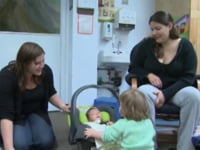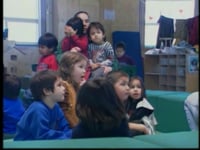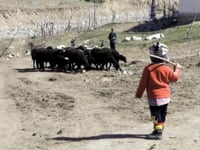3.1 Guiding and teaching
Discussions about guiding and teaching may conjure images of formal instruction in classrooms – teachers in front of classes, “telling” students what they want them to know. However, guiding and teaching is a much broader concept. We can think of this as “steering” children in a certain direction or facilitating their learning and development. For very young children, this might mean supporting them to wait a little longer to have a turn or providing them with opportunities to investigate something they are curious about. And of course, parents are children’s first teachers.
Sir Kevan Collins, former chief executive of the Education Endowment Foundation, identifies conversations with children as a priority for early childhood educators. Listen to him talk about the concept of “sustained shared thinking” and “dialogic discourse”.
What kind of conversations is Sir Collins talking about?
Think about the last conversation you had with a young child. Was it a “meaningful authentic conversation”?
As Sir Collins says “it’s always about improving…to have better learning conversations with our children”. How can you apply this to interactions with children in your life?
Play and learning
Around the world, educators debate traditional versus progressive approaches to teaching and learning. Traditional educational approaches emphasize the basics and the acquisition of solid skills through structured direct instruction, pre-established learning goals and measurable results. Less traditional and more progressive approaches focus on understanding, problem-based learning and projects rather than on specific skills and knowledge. Listen now as Dr. Janette Pelletier, professor emerita at the Institute of Child Study at the University of Toronto, and Dr. Patricia Chorney Rubin, director of Community Services and Early Childhood at George Brown College, describe play-based learning and play-based programs and how educators can take advantage of children’s need to play.
The next reading from the Canadian Child Care Federation looks at how play and learning are linked and briefly describes how to implement this play-based approach in early childhood settings.
As the following example shows, children’s play often offers many opportunities for learning and children learn from their peers as well as from adults:
Consider…
Nine children were standing together near the temple in the rain and ten-year-old Kaley proposed they play the rice planting game. All the children started to work with great enthusiasm, pulling up grass, or “rice seedlings”… Read more
As Margaret McCain states in the Early Years Study 4 (2020, p. 16), “early childhood education is play”. Many educators involved in delivering programs for young children highly value the importance of play. Listen as Abdalla Mjaka, a lead trainer in the Zanzibar Madrasa Resource Centre, explains this.
Our approach to guiding and teaching is greatly influenced by our view of children. If we believe children to be capable, competent and naturally curious we will respond to them in positive ways that support their development, and create environments for them to thrive. Sarah Silver, former executive director of University Children’s Centre in Halifax explains what the image of the child means to her.
Listen as Dr. Jean Clinton, clinical professor of Psychiatry and Behavioural Neuroscience at McMaster University, explains the importance of caregivers examining their view of children and then on the need to pay attention to the relationship between the adult and child.
In the next video, Greta is intensely curious about a new baby. As you watch the interaction, consider Clinton’s descriptions of connection vs. correction. Consider how the mother guides Greta’s interest, encourages and monitors Greta to be gentle, and models language development.
How does Greta’s mother respect Greta’s interest in the baby?
What do you think might have happened if Greta’s mother told Greta to leave the baby alone?
What do you think Greta’s mother holds as her image of her child?
Supporting children’s learning and development
Educators can take advantage of learning opportunities that emerge AND they can structure learning opportunities into a child’s day. Educators can guide learning experiences that are within children’s zone of proximal development. The zone of proximal development is a concept developed by Lev Vygotsky. It refers to the difference between what an individual can do on his/her own and that which s/he can do with help or support from an adult or peer who is more capable. According to Vygotsky, working in the zone of proximal development should be the target for each learner. Find out more about Vygotsky in Ecology of Childhood, page 1.1.
As mentioned on the beginning of this page, parents are children’s first teachers. Watch the next video to see how a parent takes advantage of the learning opportunity when their 2-year-old tries to put on their own shoes.
What does this parent do to support the child to develop this new skill?
Why does the parent not immediately correct the child when the shoes are on the wrong feet?
Adults can help to bridge or scaffold between the skills a child has and those that he or she can acquire with some assistance. Labelling of objects and events, sorting, sequencing, comparing, noting means-ends or cause-effect relationships, understanding emerging concepts of number and recognizing print symbols are skills that young children can acquire.
When adults scaffold children’s learning, they support the children through the problem-solving process, encouraging them to try something new, persist, and find alternative solutions. The adult challenges children to use their observations to predict and draw conclusions, to think about how things work, to think about why something happened; and then encourages children to reflect on what they could do differently or change the next time.
In the following video you will see a young boy experimenting with balance and weights.
How did the physical environment and the early childhood educator encourage exploration?
What do you think the young boy was experiencing in this play?
If you were the early childhood educator, what might you do next, if anything?
Educators in effective early childhood programs regularly engage in adult-child interactions that challenge, encourage joint attention and negotiate sustained shared thinking. Did you see examples of these types of interactions in this exchange?
Listen now as Dr. Joan Durrant, associate professor of Family Social Sciences at the University of Manitoba, explains the concept of scaffolding.
Can you think of a skill you have acquired through scaffolded learning?
What would you identify as key qualities in an adult who is trying to support scaffolded learning for children?
Let’s look at some examples of adults supporting children’s learning and development.
1. Medical play
The topic of medical play is introduced in the Ecology of Childhood module. The next video includes an explanation and demonstration of how child-sized medical equipment can be used in a therapeutic play situation to reduce a child’s anxiety before an intravenous procedure. Note the way the child life specialist scaffolds the child’s understanding of the procedure.
How did this play session seem to affect the child?
How did the child life specialist use scaffolding? What other beneficial strategies did you notice the child life specialist using?
How can these strategies be used to help children cope with anxiety-provoking situations outside of the health care system?
2. Supporting emerging literacy
A second example of how adults can support learning and development relates to the important role adults have supporting children’s emerging literacy.
Janette Pelletier explains that before children can learn to read, they must be able to distinguish sounds within words, recognize letters of the alphabet and connect letters to sounds. She gives examples of ways we can support children’s emerging literacy abilities in a playful and natural way.
Pelletier is also interested in how children develop an understanding of print. She describes her research and how children’s writing samples change as they acquire the alphabetic principle.
The examples below were made by four-year-olds asked to write, “Daddy has three hockey sticks.”

The next videos discuss and show wonderful ways to support children’s language and literacy abilities. The first video is part of the video series Our Children Our Ways: Early Childhood Education in First Nations and Inuit Communities. The second video was filmed in Madrasa preschool programs in East Africa. The wonder of hearing stories, the stimulating environments, the active learning materials and the encouraging teachers provide many different opportunities to support language and literacy skills.
As you watch children involved in language and literacy activities in different parts of the world, what are the various strategies you noticed educators using to engage children?
Why do you think these are important?
The Ontario Institute for Studies in Education at the University of Toronto has an innovative literacy website. It compares literacy development to a healthy diet; as all the food groups are needed for healthy physical growth, a variety of literacy experiences are needed for literacy development. The site, which is geared to pre-Kindergarten to grade six, contains information and demonstration videos of literacy instruction.
3. Supporting emerging numeracy
A final example highlights the adult’s role supporting children’s emerging numeracy. Cognitive development theorists such as Jean Piaget believe young children gradually build a conceptual framework, which is the basis for mathematical understanding. Children construct key math concepts when they interact with real materials and people. Matching, classifying, comparing and ordering provide a strong foundation for when children begin to learn more formal mathematics in school. These four categories of mathematical concepts are part of the daily lives and play in early childhood.
Dr. Jo-Anne LeFevre, director of the Institute of Cognitive Science at Carleton University, provides some practical examples of how mathematics and numeracy can be integrated throughout the day in an early childhood program.
This resource sheet from the Canadian Child Care Federation has a variety of simple activities and experiences that support numeracy development.
Preschools and primary schools can build on children’s informal, everyday math to develop the concepts, procedures and symbolism of mathematics. An environment rich with objects and materials is a starting point but what is most important is what children do with them.
In the next video, observe how children in East Africa are building mathematical understanding by playing with simple materials.
What is meant by the “language of math” for young children? What are some examples?
What mathematical concepts can children explore with these materials:
- twigs of various lengths
- a variety of buttons
- a variety of seashells
The readings and video above focus on the benefits of exposing children to math concepts during daily tasks using everyday items that are easily-available and that provide active learning opportunities. As you look at the photos in the following slideshow, consider how each play environment might allow a child to explore math concepts.
Reflective practice
Reflective practice, or thinking about what you do, is a concept that has been applied to many fields and disciplines. Deb Curtis is a renowned expert in the early learning field who has written numerous books and articles on this and other topics. Listen to her define this concept and explain how she applies it to her work with young children.
Deb Curtis and colleague Margie Carter developed the Thinking Lens as a protocol to approach reflective practice. With thanks to Deb Curtis for sharing this document, read more about each of the 6 elements and how they support reflective practice. Then listen to Curtis outline each of 6 elements and provide explanation and examples of each.
Listen to Sarah Silver share an example of a scenario at the University Children’s Centre. While you are listening, consider the 6 elements of the Thinking Lens. How does each apply? How could you use this protocol/tool to guide your practice in this situation?
Observation and documentation are important parts of reflective practice and the Thinking Lens.
View the following slide show highlighting a variety of documentation at Inspired by Wonder, a children’s program in Winnipeg, Manitoba. Each photo provides an example, something that can inspire your practice.
You will see that these are photos of displays that could be used with children, parents, and/or staff. As explained by Deb Curtis, it is important to think about documentation as a process. So imagine the play, activity or experiences that led to the creation of each display. If you are not able to clearly see the pictures of what has been documented, or read the narrative of what the children or staff have recorded, focus on the location, arrangement or design.
Listen to Dr. Christine McLean, assistant professor in Child and Youth Study at Mount St. Vincent University, expand on the concept of reflective practice and highlight why reflective practice is so important.
Want to know more? Incorporating reflective practice in your work
How can you incorporate reflective practice in your work with children? What are the barriers or challenges? What tools do you need? What steps can you take? Listen to the following videos for some ideas and inspiration.
This page has provided much information about your role in supporting children’s learning and development. What are the takeaways for you?









